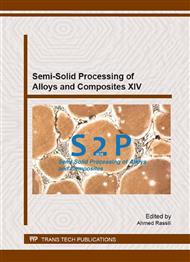p.192
p.199
p.205
p.216
p.222
p.228
p.237
p.243
p.251
Filling, Feeding and Defect Formation of Thick-Walled AlSi7Mg0.3 Semi-Solid Castings
Abstract:
Aluminium semi-solid castings have gained increased attention due to their superior mechanical properties, lower porosity compared to conventional high pressure die cast material. These characteristics suggests that semi-solid casting should be suitable to produce thick-walled structural components, yet most successful applications of semisolid casting have been for thin-walled components. There is a lack of understanding on filling and feeding related defect formation for semi-solid castings with thick-walled cross-sections. In the current study an AlSi7Mg0.3 aluminium alloy was used to produce semi-solid castings with a wall thickness of 10mm using a Vertical High Pressure Die Casting machine. The RheoMetalTM process was used for slurry preparation. The primary solid α-Al fraction in the slurry was varied together with die temperature. The evaluation of the filling related events was made through interrupted shots, stopping the plunger at different positions. Microscopy of full castings and interrupted test samples were performed identifying the presence of surface segregation layer, shear bands, gas entrapment, shrinkage porosity as well as burst feeding.
Info:
Periodical:
Pages:
222-227
Citation:
Online since:
September 2016
Authors:
Price:
Сopyright:
© 2016 Trans Tech Publications Ltd. All Rights Reserved
Share:
Citation:


